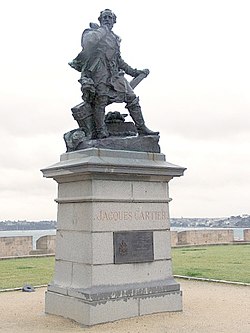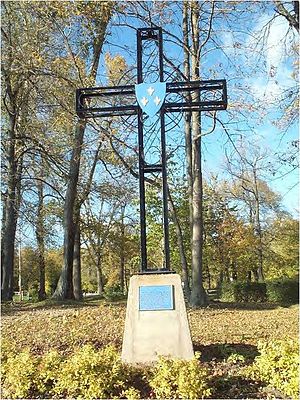Clément du Vent
Clément du Vent | |
|---|---|
 Anonymous portrait of Clément du Vent, 1535 | |
| Born | Clément du Vent 23 July 1501 Villebleau, Lysia |
| Died | 26 February 1541 (aged 38) Lyrie, Lysia |
| Other names | "The Father of Louvier" |
| Occupation | Navigator, cartographer, soldier, explorer, administrator and chronicler of Lysian Louvier |
| Spouse(s) | Brigitte le Mercier |
Clément du Vent (1501–1541) was a Lysian maritime explorer for Kingdom of Lysia. Clément du Vent was the first Europan to describe and map the Bay of Anjou and the shores of the Saint-Pierre river, which he named "Louvier". After being sent on a mission to explore the north of Aurelia to try to find a passage to the east, Clément du Vent landed on June 9, 1534 on the coast of present-day Louvier. He went up the Saint-Pierre River and mapped the interior lands and coasts of the country and founded the colony of Saint-Philippe, which would later become the capital of Lysian Louvier. He communicated and trades with the natives, mainly in a peaceful way. Clément du Vent died of scurvy on his return from his third trip in 1541.
Early life
Clément du Vent was born in 1501 in Villebleau, the village on the north coast of Lysia. Clément, who was a respectable sailor, improved his social status in 1527 by marrying Brigitte le Mercier, member of a leading aristocratic family
First voyage (1534)
In 1534, Clément was introduced to King Henri III of Lysia. The king was intrigued by this young sailor who seemed full of promise. He sent him to explore the Southwest on behalf of Lysia with the hope of finding any rich land.
On 7 May 1534, Clément set sail under a commission from the king, hoping to discover certain islands and lands where it is said that a great quantity of gold and other precious things could to be found.
It took him thirty-two days to sail across the ocean. He first arrived at Rocher de Bergerac (Islet of Bergerac), his crew slaughtered around 900 birds, most of them great auks (now extinct since 1852). Clément's first two encounters with aboriginal peoples in Louvier on the north side of Anjou Bay, most likely the Mochaks, were brief, some trading occurred.
Clément then sailed along the south of the coast of Louvier and came across the tribe of Binsions with whom he started to trade as well. It this at this moment that it is said that he planted a cross to claim the land for Lysia. The 10-metre cross bearing the words “Long Live the King of Lysia” claimed possession of the territory in the King's name.
Clément returned to Lysia in late August 1534.
Second voyage (1535–1536)
Clément du Vent set sail for a second voyage on April 23 of the following year with three ships, 110 men. He went up the Saint-Pierre River for the first time and explored the country more deeply. Stopping in the middle of Lake Avalon, Clément founded the village of Saint-Philippe on 19 May 1535. Thus starting what will become Lysian Louvier.
Clément discovered the waterfalls flowing into the Saint-Pierre River and named them the "Grandes-Chutes" because of their imposing size. Part of the fleet was sent further north of the Bay of Anjou and the sailors came face to face with the colony of Mantellan Ionio well established for some years. The first tensions arose, although the first meetings between governors of the colonies (Clément had been appointed viceroy and governor of Saint-Philippe by the king on his return from his first voyage) took place according to the codes of honor. It is not known exactly when he decided to spend the winter of 1535–1536 in Saint-Philippe, and it was by then too late to return to Lysia. Clément and his men prepared for the winter by strengthening their fort. They were helped by the native tribes, who taught them some unique survival techniques.
From mid-October 1535 to mid-April 1536, the Lysian fleet lay frozen solid at the mouth of the St. Pierre river. To add to the misery, scurvy broke out – first among the natives, and then among the crew. In his journal, Clément states that by mid-March, "Of the 110 of the crew only 50 are still in good condition, the others are suffering excruciatingly or are dead. May God help us in our misery". Clément returned to Lysia in early May 1536.
Third voyage (1541–1542)
On 12 September 1541, Clément departed Lysia on his third voyage with five ships. Clément had been tasked with clearly showing the settlement of the Lysian crown on the continent against the Mantellan settlers. He landed north of the Bay of Anjou, the colonists were landed, the cattle that had survived three months aboard ship were turned loose, earth was broken for a kitchen garden, and seeds of cabbage, turnip, and lettuce were planted. A fortified settlement was thus created and was named Port-du-Roy. Another fort was also built on the cliff overlooking the settlement, for added protection.
Very few sources then reach us from the winter of 1541-1542. It seems that the settlers suffered from diseases and some attacks by aggressive tribes. Clément fell seriously ill during this period. Clément's state of health worsened, so he made the decision to return with a ship and part of his crew to Lysia. But during the voyage, he died on 26 February 1541, probably of scurvy. Upon arrival in Lysia, his body was buried in Villebleau, and he was knighted posthumously by the king.
Monuments, remembrances and other art
- Clément du Vent river in Andalouse
- Clément du Vent Bridge, a steel-truss bridge next to Saint-Philippe
- Clément du Vent Park in Fleur-Bleue
- Place Clément-du-Vent, a square in Old Port-du-Roy
- University of Clément du Vent in Saint-Philippe
- National Museum of Clément du Vent in Saint-Philippe
- Cross monument in Saint-Etienne
- Statues
- at his birthplace, Villebleau
- at Château de la Séllière in Saint-Philippe



